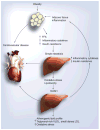Atherogenic dyslipidemia and cardiovascular risk in children with nonalcoholic fatty liver disease
- PMID: 22162978
- PMCID: PMC3234131
- DOI: 10.2217/clp.11.19
Atherogenic dyslipidemia and cardiovascular risk in children with nonalcoholic fatty liver disease
Abstract
Nonalcoholic fatty liver disease is now regarded as the most common form of chronic liver disease in adults and children. The close association between nonalcoholic fatty liver disease (NAFLD) and the metabolic syndrome has been extensively described. Moreover, a growing body of evidence suggest that NAFLD by itself confers a substantial cardiovascular risk independent of the other components of the metabolic syndrome. Given the significant potential for morbidity and mortality in these patients, and the large proportion of both pediatric and adult population affected, it is important that we clearly define the overall risk, identify early predictors for cardiovascular disease progression, and establish management strategies. In this article, we will focus on current data linking NAFLD and the severity of liver damage present in children with cardiovascular risk.
Figures

References
-
- Chan DF, Li AM, Chu WC, et al. Hepatic steatosis in obese Chinese children. Int J Obes Relat Metab Disord. 2004;28:1257–1263. - PubMed
-
- Wieckowska A, Feldstein AE. Nonalcoholic fatty liver disease in the pediatric population: a review. Curr Opin Pediatr. 2005;17:636–641. - PubMed
-
- Wiegand S, Keller KM, Robl M, et al. Obese boys at increased risk for nonalcoholic liver disease: evaluation of 16,390 overweight or obese children and adolescents. Int J Obes (Lond) 2010;34:1468–1474. - PubMed
-
- Schwimmer JB, Deutsch R, Kahen T, Lavine JE, Stanley C, Behling C. Prevalence of fatty liver in children and adolescents. Pediatrics. 2006;118:1388–1393. - PubMed
-
- Brunt EM. Pathology of fatty liver disease. Mod Pathol. 2007;20(Suppl. 1):S40–S48. - PubMed
Grants and funding
LinkOut - more resources
Full Text Sources
